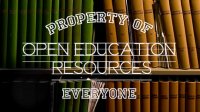Transitioning to Open Educational Resources
Your content has been saved!
Go to My Saved Content.Over the course of educational timelines, the textbook has reigned as the authority in content delivery. The textbook's reign has gone unmatched for many years, but its pedestal is beginning to wobble. This is not to say that credible information is no longer in bound books, rather that credible information options have taken on many new forms.
Over the past two years, I've been working with my district to transition from the popular textbook towards Open Educational Resources, or OER. One of the leading benefits of OER options is that they are free and open to educators. That in itself is a reason to inquire. The information has been vetted for credibility and some of it is derived from some of the world's top colleges and universities.
The other end of this transition is moving one's resources to a cloud-based or digital application. Many educators have been compiling curriculum binders for years, while some have been saving every word of their curriculum to a MS Word document in the My Documents folder on their hard drives. While these methods are practical and work well, they are vulnerable and are limited in their distribution and sharing options.
A Flexible Approach to Content
Recently at Burlington Public Schools, we have moved toward opening up our course content and started organizing our faculty-created resources -- presentations, assignment sheets, etc. -- along with OER options. What we are doing is giving our faculty and our students more ways to connect and share dynamic, developing content. Plus, a digital resource created by teachers in conjunction with OER does not require edition upgrades. What's more, teachers can change and update content when they need to. This option gives them full autonomy over their classroom content.
To manage this transition, we started using Net Texts as our content management and distribution application. Net Texts is a free application that has many similarities to iTunesU. It allows our teachers to post content -- PDFs, videos, photos, audio, etc. -- from their web-based management system directly to the students. Teachers can frontload courses for the year and update at any time. When there is an update, students will receive a red badge on their Net Texts app. Once they sync with the wi-fi, they can update the course. The other advantage of Net Texts is that students can use it offline (if no updates are pending) and open posted resources such as PDFs in third party applications (like Notability).
The teachers like this approach because they have full autonomy over their content, can update it at anytime throughout the year, and can deliver it directly to their students. Our students like OER because of the intuitive interface and the ability to connect with their classes both online and offline. Plus, some of our foreign language students who are traveling abroad can easily stay connected through their iPad and the Net Texts app. This allows students to go out and see the world while participating in their respective classrooms.
Four Suggested OER Options
One of the big misconceptions about transitioning away from textbooks is that teachers have to create their own textbook. This is false. There are endless avenues for collecting resources and digitally organizing the resources you've already built into your curriculum. This process hardly means you have to start from scratch, however; it is about taking what you have and organizing it in a way that gives students a variety of access points to your content. As I mentioned earlier, there are lots of OER options populating on the web. Some of them are ready to use without any applications needed. Students and teachers can simply load a website to access the material.
Here are a few OER options I have used.
OER Commons
This site offers educators a place where they can connect and share globally with other educators, and work with the curriculum those educators have shared. OER Commons offers a vast database of teacher-created curriculum. The content is vetted for credibility and provides citations for reference. Users can sign up for a free account, share their own work, and access and curate their own content via their account.
CK-12 Foundation
The CK-12 Foundation offers FlexBooks, full digital texts that students and teachers can access on multiple devices. FlexBooks are available in PDF, MOBI and ePub formats. This gives many different devices access to rich content.
Project Gutenberg
Project Gutenberg could be considered the grandfather of open educational resources. The site has been around for a while and boasts a collection of 42,000 free ebooks. Many of our students have used Project Gutenberg to expand their reading opportunities, and our teachers have used this to access literary pieces through the iPad. Project Gutenberg offers a variety of file formats for users, so it is not limited to a singular device.
MIT Open Courseware
The MIT Open Courseware site offers educators and students access to full courses designed and taught by MIT professors. Users can access the entire course library along with the entire course packet. Course packets include video interviews with professors, syllabus, outlines, readings, assignments, projects and related resources.
